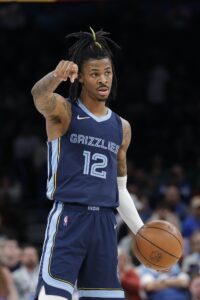The Designated Veteran extension, as we explain in our glossary entry on the subject, is a relatively new addition to the NBA’s Collective Bargaining Agreement. It allows players with seven, eight, or nine years of NBA service, who would normally be eligible for a maximum starting salary of 30% of the cap, to qualify for a “super-max” contract that starts at 35% of the cap, a level normally reserved players with 10+ years of experience.
A player who has seven or eight years of NBA service with one or two years left on his contract becomes eligible for a Designated Veteran extension if he meets the required performance criteria and hasn’t been traded since his first four years in the league. A Designated Veteran contract can also be signed by a player who is technically a free agent if he has eight or nine years of service and meets the required criteria.
The performance criteria is as follows (only one of the following must be true):
- The player was named to an All-NBA team and/or was named the NBA Defensive Player of the Year in the most recent season, or in two of the last three seasons.
- The player was named the NBA MVP in any of the three most recent seasons.
Nikola Jokic, Devin Booker, and Karl-Anthony Towns have all signed super-max extensions this offseason. Jokic qualified for his Designated Veteran extension when he earned his first MVP award in 2021, while Booker and Towns became eligible when they made All-NBA teams in 2022.
There aren’t as many obvious candidates to meet the Designated Veteran criteria in 2022/23, but there are still a handful of players worth keeping an eye on. Here’s a look at some super-max candidates to watch during the ’22/23 season:
 Brown has never made an All-NBA team, but he was an All-Star in 2021 and received All-NBA votes in 2022, so he could very well be in the mix in 2023.
Brown has never made an All-NBA team, but he was an All-Star in 2021 and received All-NBA votes in 2022, so he could very well be in the mix in 2023.
Brown’s situation is an interesting one — he’s unlikely to sign a standard contract extension before reaching free agency because the maximum raise (20%) on his 2023/24 salary ($30,723,214) would fall well short of his projected maximum salary for the 2024/25 season as a free agent.
Meeting the super-max criteria would change that equation, making Brown eligible for a far more substantial raise on a DVE. But would the Celtics be willing to commit to a five-year super-max contract for their second-best player? The NBA hasn’t issued a cap projection for ’24/25 yet, but if we assume a $143MM cap (a $10MM bump on the projected $133MM cap for ’23/24), a five-year DVE that begins in 2024 would be worth $290MM+.
Tatum, meanwhile, made the All-NBA First Team in 2022, putting him in a very good position to maximize his earnings.
Because he’ll only have six years of NBA service under his belt at the end of the 2022/23 season, Tatum won’t have enough experience to sign a super-max extension next offseason. But if he makes another All-NBA team, he will have met the performance criteria, having earned All-NBA honors in two of the three years before he gains the necessary service time for a DVE.
That’s what happened with Jokic — he met the performance criteria in 2021, but couldn’t sign his super-max extension until he met the service time criteria in 2022. Another strong season from Tatum could put the Celtics forward in the same boat.
Siakam and VanVleet aren’t among the NBA’s top tier of superstars, but they’re certainly in the second or third tier. Siakam has actually already earned two All-NBA nods, making the Second Team in 2020 and the Third Team in 2022, while VanVleet made his first All-Star team earlier this year. An All-NBA spot for either of them in 2023 would make them super-max eligible next offseason.
Of course, even if one or the other qualifies for a DVE, I’m somewhat skeptical that the Raptors would offer Siakam or VanVleet a full super-max deal. Those contracts are typically reserved for franchise players, and Scottie Barnes may be on track to become that guy in Toronto.
It still makes sense for Siakam and VanVleet to wait to see if they become super-max eligible before they sign extensions. Meeting the performance criteria would give them a ton of extra leverage when they negotiate their next contracts, even if the Raptors aren’t willing to go the DVE route.
Both Siakam and VanVleet have two years left on their respective contracts, though VanVleet could reach unrestricted free agency in 2023, since his final year is a player option.
An All-Star in 2020, Ingram would need to take another big step forward to become a legitimate All-NBA candidate. And that won’t be easy if Zion Williamson‘s return and a full season of CJ McCollum cut into his scoring numbers.
As is the case with the Raptors and Siakam/VanVleet and the Celtics and Brown, it’s also unclear whether the Pelicans would be eager to put a super-max offer on the table for Ingram even if he qualifies, since he may not be the player the team is building around.
Still, Ingram – who has averaged at least 22.7 points per game in each of the last three seasons – is worth mentioning because he’d be eligible for a four-year super-max contract extension that begins in 2025/26 if he were to make an All-NBA team in 2023.
The rookie scale extension recipients
 Ja Morant, Darius Garland, and Zion Williamson have all signed five-year, maximum-salary rookie scale extensions this offseason that project to start at 25% of the 2023/24 cap. Based on an estimated $133MM cap, those deals would be worth $192.85MM.
Ja Morant, Darius Garland, and Zion Williamson have all signed five-year, maximum-salary rookie scale extensions this offseason that project to start at 25% of the 2023/24 cap. Based on an estimated $133MM cap, those deals would be worth $192.85MM.
However, all three extensions include Rose Rule language. This is another form of the super-max — unlike the Designated Veteran contracts, which start at 35% of the cap instead of 30%, a player who meets the Rose Rule criteria receives a starting salary worth 30% of the cap rather than 25%.
The performance criteria for a Rose Rule salary increase are essentially the exact same as for a Designated Veteran bump, but must be achieved by the end of the player’s four-year rookie contract. That means Morant, Garland, and Williamson would have to make the All-NBA team in 2023 in order to increase the projected value of their respective extensions to $231.42MM over five years — an All-NBA berth in 2024 or 2025 would be too late.
As Bobby Marks of ESPN (Insider link) writes, while Morant and Garland will earn the Rose Rule bump if they make any of the three All-NBA teams, it’s unclear if that’s the case for Zion as well or if he needs to make the First Team to qualify for the 30% max.
Of these three players, Morant – who was an All-NBA Second Teamer in 2022 – is the best bet to be part of that group of 15 again next season.
The rest
While there are other veteran players who could technically qualify for the super-max this season, none are particularly compelling candidates. Jamal Murray would meet the performance criteria with an All-NBA nod, but that’s a lot to expect from the Nuggets guard, who missed the entire 2021/22 season due to a torn ACL.
Pacers big man Myles Turner is an intriguing dark horse candidate, since he’s capable of entering the Defensive Player of the Year discussion, and winning that award would make him super-max eligible. But the odds of him staying with the Pacers all season, earning DPOY honors, and then signing a super-max deal with Indiana as a free agent are… slim, to say the least.
Ben Simmons, Dejounte Murray, and Domantas Sabonis are among the players who can no longer qualify for a DVE because they’ve been traded while on their second contracts. Donovan Mitchell and Bam Adebayo are among those who don’t have enough service time under their belts yet and would need to earn an All-NBA spot in 2024 to qualify — and again, that would hinge on them remaining with their current teams, which appears increasingly unlikely for Mitchell.
 Brown has never made an All-NBA team, but he was an All-Star in 2021 and received All-NBA votes in 2022, so he could very well be in the mix in 2023.
Brown has never made an All-NBA team, but he was an All-Star in 2021 and received All-NBA votes in 2022, so he could very well be in the mix in 2023.